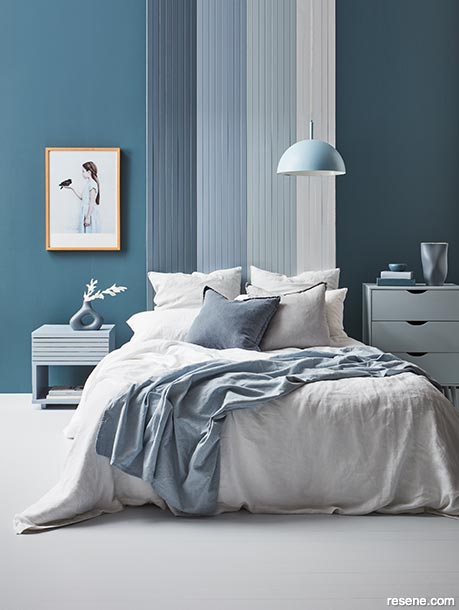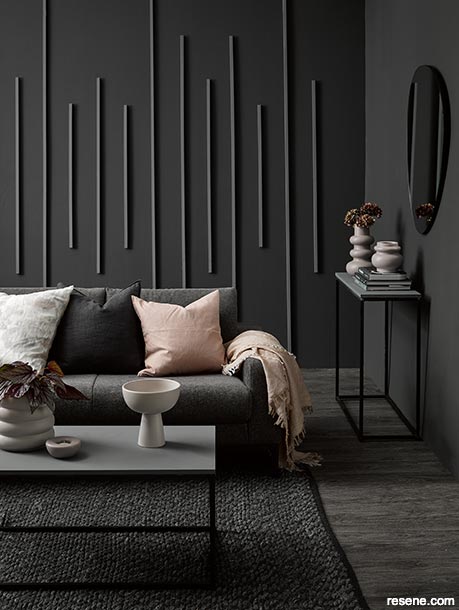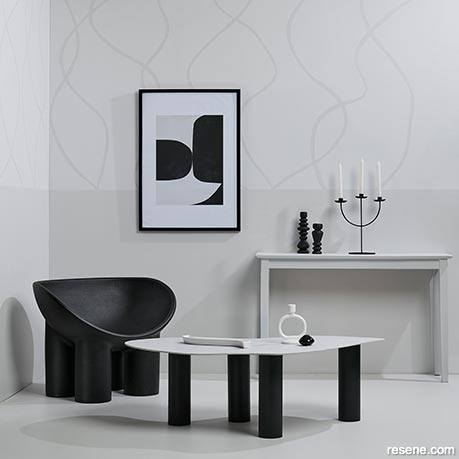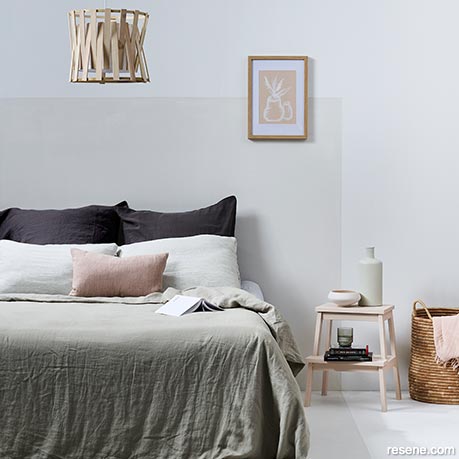From the Resene decorating blog
Here’s how to create some monochrome magic in your space.
Think ‘monochrome’ and you might picture a tuxedo, a chessboard or a zebra crossing. But when it comes to monochrome interiors, things don’t have to be quite so black and white. Because ‘monochrome’ is essentially all about that base – of whatever colour. You pick your anchoring hue then extend the palette with different shades, tones and tints of the same colour (variations created by adding white, black or grey to the base shade).
With that in mind, here’s how to create some monochrome magic in your space.

Bedroom walls in rich grey-blue Resene Rhino set the stage for rest and relaxation.
The floor is painted in Resene Iron which, together with the pale bedlinen, brings some light relief to the space to prevent an overdose of the blues. Mid-range tonal hues have been used across key items of furniture and accessories, acting as an intermediary between the lightest and darkest hues: the chest of drawers is painted in Resene Gull Grey and the bedside table in Resene Neutral Bay. The pendant lamp is painted in Resene Iron, the bedside vase in Resene Half New Denim Blue and the books are painted in Resene Rhino and Resene Neutral Bay. The most striking feature is the ombre batten headboard, going in tonal order from dark to light: Resene Neutral Bay, Resene Half Denim Blue, Resene Gull Grey and Resene Midwinter Mist. White duvet and pillowcases from Foxtrot Home, blue throw from H&M Home, blue cushion cover from H&M Home, grey cushion from Adairs. Project by Vanessa Nouwens, image by Wendy Fenwick.

The walls of this chic, cocooning living room are painted in Resene Nocturnal – a soothing, night-time off-black.
The timber flooring is stained in deep Resene Colorwood Crowshead, which allows the beautiful wood grain to shine while remaining in keeping with the room’s dark, nurturing overall feel. The battens are painted in Resene Half Tuna, slightly lighter than the base colour for contrast. Resene Half Tuna is continued on the tops of the console and coffee table to create harmony. The ribbed plant pot is painted in Resene Martini, the tealight holder and vase with dried flowers are painted in Resene Tom Tom and the short vase is in Resene High Tea. Sofa from King Living, mirror from Freedom Furniture, pink cushion from H&M Home, pattern cushion and blush throw from Allium. Project by Vanessa Nouwens, image by Wendy Fenwick.
Black and white is a perennially popular combination for good reason. It’s surprisingly flexible, oozes sophisticated simplicity and lends itself to both modern and traditional interiors. But if stark white against black is too out-there for your more nuanced tastes, you can replace the white with a medley of greys. With a vast array of Resene greys to choose from, the decision ultimately comes down to how warm or cool you want your space to feel.
To warm a room up try smoky or charcoal greys such as Resene Blue Charcoal or a deep, earthy grey like Resene Slate. Or opt for paler hues which still carry warmth – a lavender grey like Resene Gun Powder or a soft, light hue like Resene Dusted Grey and Resene Silver Sand.
If your room is filled with warm natural light, experiment with cooler tones such as Resene Zumthor or the calcite greyed white of Resene Black White.
Top tip: Greige is an ideal hue to soften your monochrome look as it combines calming grey with the warming effect of beige. To get the right greige, let nature take the lead. Think stone, rock, fur, bark, pampas grass. Some examples to try are Resene Greige, Resene Cloudy or Resene Heathered Grey.

A highlight of this minimalist space is the wall design, with the Art-Deco inspired free-flowing lines painted in Resene Concrete.
The barely-there, whisps-of-smoke effect comes courtesy of the minor shift in tone between the Resene Concrete lines and the wall in Resene Half Concrete. This delicate pattern brings a sense of movement without overwhelming the space and the vertical squiggles also create an impression of loftiness. The floor is painted in Resene Quarter Concrete, the hall table in Resene Concrete, the DIY coffee table in Resene Element, the candleholder in Resene Half Sauvignon, the DIY artwork in Resene Concrete, Resene Triple Concrete and Resene Element and the turned wooden candleholders in Resene Element. Chair from David Shaw, candleholders from H&M Home. Project by Melle van Sambeek, image by Bryce Carleton.

The rectangular block on this bedroom wall is painted in Resene Double Black White over Resene Quarter Black White.
The darker block speaks just the tiniest fraction louder than the main wall so the effect is subtle yet impactful. The colour block concept is echoed in the darker flooring that defines the bed area. The step stool (used as a side table) is painted in Resene Alpaca, the tall bottle vase is in Resene Kangaroo and the bowl is in Resene Lemon Grass. The DIY artwork is painted in Resene Alpaca and Resene Quarter Black White and the DIY pendant lamp is painted in Resene Colorwood Whitewash. Linen duvet covers, linen pillowcases, sheets, cushions, throws and basket from Citta, smoked glass from Freedom. Project by Laura Lynn Johnston, image by Bryce Carleton.
Since monochrome is simply a play on any base shade, you don’t have to stick to the classic monochrome black/white/grey narrative. You can pick any base hue you like – and for the place where you wind down, sleep and dream you might consider a soothing medley of blues. Dusty blues in particular, evoke a sense of wellbeing and serenity. Think the colour of sky before dusk, an expanse of ocean, your favourite stonewashed denims. Dusty blues are easier to live with than vibrant blues, and thanks to the grey hidden in their depths, they work well with our intense natural light.
If an all-blue palette starts to feel too same-same, there’s nothing to stop you introducing accents to break things up a little.
The grey undertones in dusty blues lay the colour pairing possibilities wide open. Try adding in a buttery yellow such as Resene Chenin or a rich precious ochre like Resene Pirate Gold for a stunning high contrast. Classic reds with a similar dusty quality, like bright Resene Pioneer Red, will add a dash of glamour. Or tread more subtly with a dusty umber such as Resene Soothe or a pastel grey-blue like Resene Longitude.
Top tip: To connect the colour palette and create a sense of cohesion, make sure you echo one of the accent hues several times in the space. For example, on a lamp, some drawers, a vase or the top of a bedside table. Spread these painted accents throughout the room so they link the whole space together.
For a truly subtle monochrome look, you can create soft contrasts by painting a colour block on your wall. Use the same hue as you’ve chosen for your walls and floor, but use it in a different strength such as a double or quarter-strength. Different tones of the ever-popular Resene Black White (it has a hint of black) will work a treat. This chalky grey-white is a popular choice with designers and homeowners because it’s neither too glaring, too warm nor too cool.
With varying strengths of a hue like this as your base, the world (well, okay, the room) is your oyster in terms of how you accessorise and personalise the space. You might choose to go full monochrome, accessorising with only whites, greys and blacks. But if you are craving a hit of colour, go for bursts of earthy ochre to inject warmth. Think sumptuous hues like Resene Manuka Honey, Resene Teak, Resene Twine and Resene Gold Coast.
Top tip: When using whites and creams in your monochrome scheme, make sure they are all either warm or cool. The same goes for accessories. If your walls contain a hint of cream, look for creaminess in your ‘white’ accessories and furnishings.
If you think saturated blacks and darkest greys a tad gloomy, think again. A dark palette can be extremely nurturing; think of it like a flotation tank, where the darkness folds around you as you sink into deep relaxation.
Try a moody grey blue like Resene Dark Knight or a deep earthy grey like Resene Slate. To give added depth and perspective to your dark palette, incorporate wall battens in a slightly lighter shade in place of artwork. Add in super-comfy ‘sink-into-me’ chairs and sofas and plenty of texture in throws and cushions.
A soft black/deep grey base lends itself to a plethora of accent shades. On the one hand, you’re perfectly entitled to dash headlong towards bright pops of colour to balance out the sobriety. On the other, you’ll need to tread a little more gently if you want to keep things nurturing and harmonious. Try soft taupe and warm minks like Resene Martini, Resene Tom Tom and Resene High Tea. Or else grey-greeny sea foam hues like Resene Emerge, dense grey-greens like Resene Blue Smoke or duck-egg greys like Resene Tiara.
Did you know… black has a reputation for making rooms feel cramped and claustrophobic? In fact, dark wall colours tend to recede from your eye blurring the edges of a space, making it appear larger, not smaller and they up the cosiness quotient.
Go bolder with your monochrome designs by going beyond black and white to create a modern classic finish in your interiors.
December 16, 2022
For help choosing colours to suit your projects, visit your local Resene ColorShop, ask a Resene Colour Expert online or book a Resene Colour Consultation.
Book a colour consult | Ask a Colour Expert | Ask a Paint Expert
Resene's decorating blog
Paint your home beautiful! Discover the latest decorating trends, tips and colour news.
![]()
Previous «
Designing on a budget: kitchens and dining rooms
![]()
Blog home
View the latest trends, tips and news
![]()
» Next
Best foot forward – paint your floor